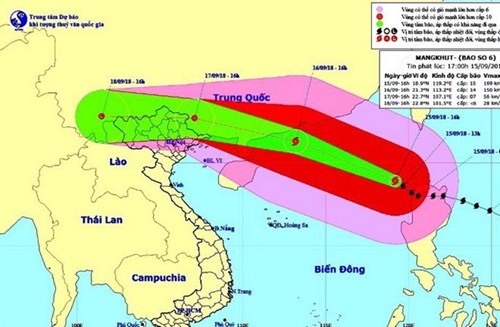Chairman of the People’s Committee of the northern port city of Hai Phong has asked the city’s Steering Committee on Natural Disaster Prevention and Control, Search and Rescue to inform all vessels not to operate at sea and cancel all waterway transport and entertainment activities at sea tourism sites.
Transport through Tan Vu-Lach Huyen bridge and some other river crossing bridges has been banned.
Localities across the city have been ready to evacuate locals in risky areas, especially in coastal and river mouth areas, while ensuring safety for dykes and works under construction.
    |
 |
|
Developments of typhoon Mangkhut |
On September 15 and 16, the city has formed inspection teams to examine preparations in localities.
In early September 16, Deputy Prime Minister Trinh Dinh Dung inspected preparations for Typhoon Mangkhut in the northern coastal province of Quang Ninh.
He visited the Ha Nam dyke system and Yen Lap lake in Quang Yen town, among others.
Lauding Quang Ninh’s efforts in responding to the storm, the Deputy PM noted that the storm has ravaged countries such as the Philippines and China, thus it is necessary to be careful prepared for it to avoid losses.
Particularly, Quang Ninh should take measures to prevent floods in mines and industrial parks, and ensure absolute safety tourists, he said.
By the noon on September 16, Quang Ninh had called all vessels ashore and reinforced dykes, while guiding locals on necessary measures to prepare for the storm.
Meanwhile in the northern coastal province of Nam Dinh, all vessels have been requested to return ashore and dock in safe shelters.
By the morning of September 16, more than 1,900 vessels with nearly 5,700 laborers had moved to safe shelters.
Localities, especially those along the coastline, had prepared plans to move locals in risky areas to safer places, while calling locals in aquatic farms and beaches to return home by September 16’s afternoon. Public buildings had also been reinforced.
According to the National Central for Hydrometeorology Forecasting, at 7am of September 16, the storm’s eye was at about 20.6 degrees north and 115.5 degrees east, on the northeast of the East Sea, about 320km east and southeast of China’s Macau. It sustained winds of up to 150km per hour.
It is forecasted is predicted to move west-northwest at a speed of 25-30km per hour, encroaching Guangxi province of China by dusk of September 16 before weakening to a low pressure.
Due to effects of the storm, in early September 17, some northern provinces of Quang Ninh, Cao Bang, Hai Phong, Bac Giang, Bac Kan and Ha Giang will see heavy rains and strong winds, with rain fall reaching about 100-150mm averagely, and high risks of floods and landslides.
Source: VNA